A Method for Estimating Forest Aboveground Biomass at the Plot Scale Combining the Horizontal Distribution Model of Biomass and Sampling Technique
Abstract
:1. Introduction
2. Materials and Methods
2.1. Data Collection
2.1.1. Sample Plot Survey and AGB Calculation
2.1.2. Data of Branch Analysis
2.2. Construction of the HDM Model for the AGB of Simao Pine
2.2.1. The Basic Idea of the HDM Construction
2.2.2. Construction of the CPM for Simao Pine
2.2.3. Construction of the HDM for the Canopy Biomass of Simao Pine
2.3. Sampling Design
2.3.1. Sampling Methods
2.3.2. Sample Shape and Sample Unit Scale
2.3.3. Calculation of Sample Size
2.3.4. Evaluation of Sampling Efficiency
3. Results
3.1. Result of the HDM Construction for the Crown Biomass of Simao Pine
3.2. Comparison of AGB Distributions Simulated by Different Distribution Models
3.2.1. Visual Comparison
3.2.2. Analysis of Coefficients of Variation
3.3. Sampling Efficiency Evaluation
3.3.1. Effect on Sample Size
3.3.2. Effect on Sampling Ratio
3.3.3. Optimization of Sampling Plans
4. Discussion
5. Conclusions
- (1)
- The power function model is the best model to fit the contour curve of the individual tree canopy of Simao pine in this study. The CPM, based on the power function, can describe the actual distribution of the canopy biomass to a certain extent and can lay the foundation for constructing the horizontal distribution model of the individual tree biomass.
- (2)
- The AGB distribution of the sample plot simulated by HDM is more uniform and continuous than that of LDM, which is more in line with the actual AGB distribution of the sample plot. Under the sampling units of each scale, the difference between the AGB sampling units of the HDM-based sample plots is more negligible than that of the LDM, the sampling unit changes are more stable, and the representativeness of the total AGB of the sample plots is stronger.
- (3)
- The biomass estimation method combining HDM and sampling techniques proposed in this study can significantly reduce the sample size and sampling ratio, effectively improving the sampling efficiency and meeting the need for rapid, accurate, and reliable estimation of forest biomass at the sample plot scale.
Author Contributions
Funding
Institutional Review Board Statement
Informed Consent Statement
Data Availability Statement
Acknowledgments
Conflicts of Interest
References
- Sun, W.; Liu, X. Review on Carbon Storage Estimation of Forest Ecosystem and Applications in China. For. Ecosyst. 2020, 7, 37–50. [Google Scholar] [CrossRef] [Green Version]
- Zhao, M.; Yang, J.; Zhao, N.; Liu, Y.; Wang, Y.; Wilson, J.P.; Yue, T. Estimation of China’s Forest Stand Biomass Carbon Sequestration Based on the Continuous Biomass Expansion Factor Model and Seven Forest Inventories From 1977 to 2013. For. Ecol. Manag. 2019, 448, 528–534. [Google Scholar] [CrossRef]
- Fang, J.; Wang, G.G.; Liu, G.; Xu, S. Forest Biomass of China: An Estimate Based on the Biomass-volume Relationship. Ecol. Appl. 1998, 8, 1084–1091. [Google Scholar]
- Shao, G.; Shao, G.; Gallion, J.; Saunders, M.R.; Frankenberger, J.R.; Fei, S. Improving Lidar-based Aboveground Biomass Estimation of Temperate Hardwood Forests with Varying Site Productivity. Remote Sens. Environ. 2018, 204, 872–882. [Google Scholar] [CrossRef]
- Zeng, P.; Zhang, W.; Li, Y.; Shi, J.; Wang, Z. Forest Total and Component Above-ground Biomass (AGB) Estimation Through C- and L-band Polarimetric Sar Data. Forests 2022, 13, 442. [Google Scholar] [CrossRef]
- Zhu, Y.; Feng, Z.; Lu, J.; Liu, J. Estimation of Forest Biomass in Beijing (China) Using Multisource Remote Sensing and Forest Inventory Data. Forests 2020, 11, 163. [Google Scholar] [CrossRef] [Green Version]
- Fang, J.; Wang, Z. Forest Biomass Estimation at Regional and Global Levels, with Special Reference to China’s Forest Biomass. Ecol. Res. 2001, 16, 587–592. [Google Scholar] [CrossRef]
- Su, Y.; Guo, Q.; Xue, B.; Hu, T.; Alvarez, O.; Tao, S.; Fang, J. Spatial Distribution of Forest Aboveground Biomass in China_ Estimation Through Combination of Spaceborne Lidar, Optical Imagery, and Forest Inventory Data. Remote Sens. Environ. 2016, 173, 187–199. [Google Scholar] [CrossRef] [Green Version]
- Yu, Y.; Pan, Y.; Yang, X.G.; Fan, W.Y. Spatial Scale Effect and Correction of Forest Aboveground Biomass Estimation Using Remote Sensing. Remote Sens. 2022, 14, 2828. [Google Scholar] [CrossRef]
- Lu, D.; Chen, Q.; Wang, G.; Liu, L.; Li, G.; Moran, E. A Survey of Remote Sensing-based Aboveground Biomass Estimation Methods in Forest Ecosystems. Int. J. Digit. Earth 2016, 9, 63–105. [Google Scholar] [CrossRef]
- Abbas, S.; Wong, M.S.; Wu, J.; Shahzad, N.; Irteza, S.M. Approaches of Satellite Remote Sensing for the Assessment of Above-ground Biomass Across Tropical Forests: Pan-tropical to National Scales. Remote Sens. 2020, 12, 3351. [Google Scholar] [CrossRef]
- Silva, C.A.; Duncanson, L.; Hancock, S.; Neuenschwander, A.; Thomas, N.; Hofton, M.; Fatoyinbo, L.; Simard, M.; Marshak, C.Z.; Armston, J.; et al. Fusing Simulated Gedi, ICESat-2 and Nisar Data for Regional Aboveground Biomass Mapping. Remote Sens. Environ. 2021, 253, 112234. [Google Scholar] [CrossRef]
- Vafaei, S.; Soosani, J.; Adeli, K.; Fadaei, H.; Naghavi, H.; Pham, T.D.; Bui, D.T. Improving Accuracy Estimation of Forest Aboveground Biomass Based on Incorporation of ALOS-2 PALSAR-2 and Sentinel-2A Imagery and Machine Learning: A Case Study of the Hyrcanian Forest Area (Iran). Remote Sens. 2018, 10, 172. [Google Scholar] [CrossRef] [Green Version]
- Ou, G.; Li, C.; Lv, Y.; Wei, A.; Xiong, H.; Xu, H.; Wang, G. Improving Aboveground Biomass Estimation of Pinus densata Forests in Yunnan Using Landsat 8 imagery By Incorporating Age Dummy Variable and Method Comparison. Remote Sens. 2019, 11, 738. [Google Scholar] [CrossRef] [Green Version]
- Chen, Q.; Laurin, G.V.; Valentini, R. Uncertainty of Remotely Sensed Aboveground Biomass Over an African Tropical Forest: Propagating Errors from Trees to Plots to Pixels. Remote Sens. Environ. 2015, 160, 134–143. [Google Scholar] [CrossRef]
- Hill, A.; Mandallaz, D.; Langshausen, J. A Double-sampling Extension of the German National Forest Inventory for Design-based Small Area Estimation on Forest District Levels. Remote Sens. 2018, 10, 1052. [Google Scholar] [CrossRef] [Green Version]
- Strîmbu, V.F.; Ene, L.T.; Gobakken, T.; Gregoire, T.G.; Astrup, R.; Næsset, E. Post-stratified Change Estimation for Large-area Forest Biomass Using Repeated Als Strip Sampling. Can. J. For. Res. 2017, 47, 839–847. [Google Scholar] [CrossRef] [Green Version]
- Nelson, R.; Gobakken, T.; Næsset, E.; Gregoire, T.; Ståhl, G.; Holm, S.; Flewelling, J. Lidar Sampling—Using an Airborne Profiler to Estimate Forest Biomass in Hedmark County, Norway. Remote Sens. Environ. 2012, 123, 563–578. [Google Scholar] [CrossRef]
- Ene, L.T.; Næsset, E.; Gobakken, T. Simulation-based Assessment of Sampling Strategies for Large-area Biomass Estimation Using Wall-to-wall and Partial Coverage Airborne Laser Scanning Surveys. Remote Sens. Environ. 2016, 176, 328–340. [Google Scholar] [CrossRef]
- Parrott, D.L.; Lhotka, J.M.; Fei, S.; Shouse, B.S. Improving Woody Biomass Estimation Efficiency Using Double Sampling. Forests 2012, 3, 179–189. [Google Scholar] [CrossRef] [Green Version]
- Knapp, N.; Huth, A.; Fischer, R. Tree Crowns Cause Border Effects in Area-based Biomass Estimations from Remote Sensing. Remote Sens. 2021, 13, 1592. [Google Scholar] [CrossRef]
- Kershaw, J.A.; Maguire, D.A. Crown Structure in Western Hemlock, Douglas-Fir, and Grand Fir in Western Washington: Trends in Branch-Level Mass and Leaf Area. Can. J. For. Res. 1996, 25, 1897–1912. [Google Scholar] [CrossRef]
- Xu, M.; Harrington, T.B. Foliage Biomass Distribution of Loblolly Pine as Affected by Tree Dominance, Crown Size, and Stand Characteristics. Can. J. For. Res. 1998, 28, 887–892. [Google Scholar] [CrossRef]
- Nielsen, C.C.N.; Mackenthum, G. Die horizontale Varia-tion der Feinwurzelintensität in Waldböden in Abhängigkeit vonder Bestockungsdichte. Einerechnerische Methode zur Bestimmung der “Wurzelintensitätsglocke” an Einzelbäumen. Allg. Forst Und Jagdztg. 1991, 162, 112–119. [Google Scholar]
- Fehrmann, L.; Kuhr, M.; von Gadow, K. Zur Analyse Der Grobwurzelsysteme Großer Waldbäume and Fichte [Picea abies (L.) Karst.] Und Buche [Fagus sylvatica L.] (In German: “Analyis of the Coarse Root Systems of Large Trees at Spruce [Picea abies (L.) Karst.] and Beech [Fagus sylvatica L.]”). Forstarchiv 2003, 74, 96–102. [Google Scholar]
- Mascaro, J.; Detto, M.; Asner, G.P.; Muller-Landau, H.C. Evaluating Uncertainty in Mapping Forest Carbon with Airborne LiDAR. Remote Sens. Environ. 2011, 115, 3770–3774. [Google Scholar] [CrossRef]
- Kleinn, C.; Magnussen, S.; Nölke, N.; Magdon, P.; Álvarez-gonzález, J.G.; Fehrmann, L.; Pérez-cruzado, C. Improving Precision of Field Inventory Estimation of Aboveground Biomass Through an Alternative View on Plot Biomass. For. Ecosyst. 2020, 7, 760–769. [Google Scholar] [CrossRef]
- Pérez-cruzado, C.; Kleinn, C.; Magdon, P.; Álvarez-gonzález, J.G.; Magnussen, S.; Fehrmann, L.; Nölke, N. The Horizontal Distribution of Branch Biomass in European beech: A Model Based on Measurements and TLS based Proxies. Remote Sens. 2021, 13, 1041. [Google Scholar] [CrossRef]
- Carvalho, J.P.; Parresol, B.R. Additivity in Tree Biomass Components of Pyrenean Oak (Quercus pyrenaica Willd.). For. Ecol. Manag. 2003, 179, 269–276. [Google Scholar] [CrossRef]
- Stenberg, P.; Kuuluvainen, T.; Kellomäki, S.; Grace, J.C.; Jokela, E.J.; Gholz, H.L. Crown Structure, Light Interception and Productivity of Pine Trees and Stands. Ecol. Bull. 1994, 43, 20–34. [Google Scholar]
- Kellomäki, S. A Model for the Relationship between Branch Number and Biomass in Pinus Sylvestris Crowns and the Effect of Crown Shape and Stand Density on Branch and Stem Biomass. Scand. J. For. Res. 1986, 1, 455–472. [Google Scholar] [CrossRef]
- Wang, D.; Yang, L.; Shi, C.; Li, S.; Tang, H.; He, C.; Cai, N.; Duan, A.; Gong, H. QTL Mapping for Growth-related Traits By Constructing the first Genetic Linkage Map in Simao Pine. BMC Plant Biol. 2022, 22, 48. [Google Scholar] [CrossRef] [PubMed]
- Ou, G.; Wang, J.; Xu, H.; Chen, K.; Zheng, H.; Zhang, B.; Sun, X.; Xu, T.; Xiao, Y. Incorporating Topographic Factors in Nonlinear Mixed-effects Models for Aboveground Biomass of Natural Simao Pine in Yunnan, China. J. For. Res. 2016, 27, 119–131. [Google Scholar] [CrossRef]
- Zhu, L.M.; Xu, H. Study on Single Biomass Model for Pinus kesiya var. langbianensis. For. Sci. Technol. 2009, 34, 19–23. [Google Scholar]
- Zhou, L.; Ou, G.L.; Wang, J.F.; Xu, H. Light Saturation Point Determination and Biomass Remote Sensing Estimation of Pinus kesiya var. langbianensis Forest Based on Spatial Regression Models. Sci. Silvae Sin. 2020, 56, 38–47. [Google Scholar]
- Ou, G.; Xiao, Y.; Wang, J.; Xu, H.; Liu, Z. Modeling Tree Crown Structure of Simao Pine (Pinus kesiya var. langbianensis) Natural Forest. Acta Ecol. 2014, 34, 1663–1671. [Google Scholar]
- Gao, H.; Bi, H.; Li, F. Modelling Conifer Crown Profiles as Nonlinear Conditional Quantiles: An Example with Planted Korean Pine in Northeast China. For. Ecol. Manag. 2017, 398, 101–115. [Google Scholar] [CrossRef]
- Sun, Y.; Gao, H.; Li, F. Using Linear Mixed-effects Models with Quantile Regression to Simulate the Crown Profile of Planted Pinus Sylvestris Var. Mongolica Trees. Forests 2017, 8, 446. [Google Scholar] [CrossRef] [Green Version]
- Baldwin, V.C.; Peterson, K.D. Predicting the Crown Shape of Loblolly Pine Trees. Can. J. For. Res. 1997, 27, 102–107. [Google Scholar] [CrossRef]
- LY/T 2908—2017; Regulations for Age-Class and Age-Group Division of Main Tree-Species. Chinese National Technical Committee for the Standardization of Forest Resources, Standards Press of China: Beijing, China, 2017.
- Dong, C.; Wang, C.; Wu, B.; Guo, Y.; Han, Y. Study on Crown Profile Models for Chinese Fir (Cunninghamia lanceolata) in Fujian Province and Its Visualization Simulation. Scand. J. For. Res. 2016, 31, 302–313. [Google Scholar] [CrossRef]
- Gao, H.; Dong, L.; Li, F. Modeling Variation in Crown Profile with Tree Status and Cardinal Directions for Planted Larix olgensis Henry Trees in Northeast China. Forests 2017, 8, 139. [Google Scholar] [CrossRef] [Green Version]
- Wang, D.; Zhou, Q.; Yang, P.; Zhong, X. Design of a Spatial Sampling Scheme Considering the Spatial Autocorrelation of Crop Acreage Included in the Sampling Units. J. Integr. Agric. 2018, 17, 2096–2106. [Google Scholar] [CrossRef]
- Wang, D.; Li, Z.; Zhou, Q.; Yang, P.; Chen, Z. An Optimized Two-stage Spatial Sampling Scheme for Winter Wheat Acreage Estimation Using Remotely Sensed Imagery. Int. J. Remote Sens. 2018, 40, 2014–2033. [Google Scholar] [CrossRef]
- GB/T 38590—2020; Technical Regulations for Continuous Forest Inventory. Chinese National Technical Committee for the Standardization of Forest Resources, Standards Press of China: Beijing, China, 2020.
- Andersena, H.; Breidenbach, J. Statistical Properties of Mean Stand Biomass Estimators in a Lidar-based Double Sampling Forest Survey Design. Int. Arch. Photogramm. Remote Sens. Spat. Inf. Sci. 2007, 36, 8–13. [Google Scholar]
- Hawbaker, T.J.; Keuler, N.S.; Lesak, A.A.; Gobakken, T.; Contrucci, K.; Radeloff, V.C. Improved Estimates of Forest Vegetation Structure and Biomass with a Lidar-optimized Sampling Design. J. Geophys. Res. Atmos. 2009, 114, G00E04. [Google Scholar] [CrossRef]
- Næsset, E.; Gobakken, T.; Bollandsås, O.M.; Gregoire, T.G.; Nelsonc, R.; Ståhl, G. Comparison of Precision of Biomass Estimates in Regional field Sample Surveys and Airborne Lidar-assisted Surveys in Hedmark County, Norway. Remote Sens. Environ. 2013, 130, 108–120. [Google Scholar] [CrossRef] [Green Version]
- Ståhl, G.; Holm, S.; Gregoire, T.G.; Gobakken, T.; Næsset, E.; Nelson4, R. Model-based Inference for Biomass Estimation in a Lidar Sample Survey in Hedmark County, Norway. Can. J. For. Res. 2011, 41, 96–107. [Google Scholar] [CrossRef] [Green Version]
- Wirasatriya, A.; Pribadi, R.; Iryanthony, S.B.; Maslukah, L.; Sugianto, D.N.; Helmi, M.; Ananta, R.R.; Adi, N.S.; Kepel, T.L.; Ati, R.N.A.; et al. Mangrove Above-Ground Biomass and Carbon Stock in the Karimunjawa-Kemujan Islands Estimated from Unmanned Aerial Vehicle-Imagery. Sustainability 2022, 14, 706. [Google Scholar] [CrossRef]
- López-Serrano, P.M.; Domínguez, J.L.C.; Corral-Rivas, J.J.; Jiménez, E.; López-Sánchez, C.A.; Vega-Nieva, D.J. Modeling of Aboveground Biomass with Landsat 8 OLI and Machine Learning in Temperate Forests. Forests 2020, 11, 11. [Google Scholar] [CrossRef] [Green Version]
- Chen, L.; Wang, Y.; Ren, C.; Zhang, B.; Wang, Z. Assessment of Multi-Wavelength SAR and Multispectral Instrument Data for Forest Aboveground Biomass Mapping Using Random Forest Kriging. For. Ecol. Manag. 2019, 447, 12–25. [Google Scholar] [CrossRef]
- Zhang, J.; Lu, C.; Xu, H.; Wang, G. Estimating Aboveground Biomass of Pinus densata-Dominated Forests Using Landsat Time Series and Permanent Sample Plot Data. J. For. Res. 2019, 30, 1689–1706. [Google Scholar] [CrossRef]
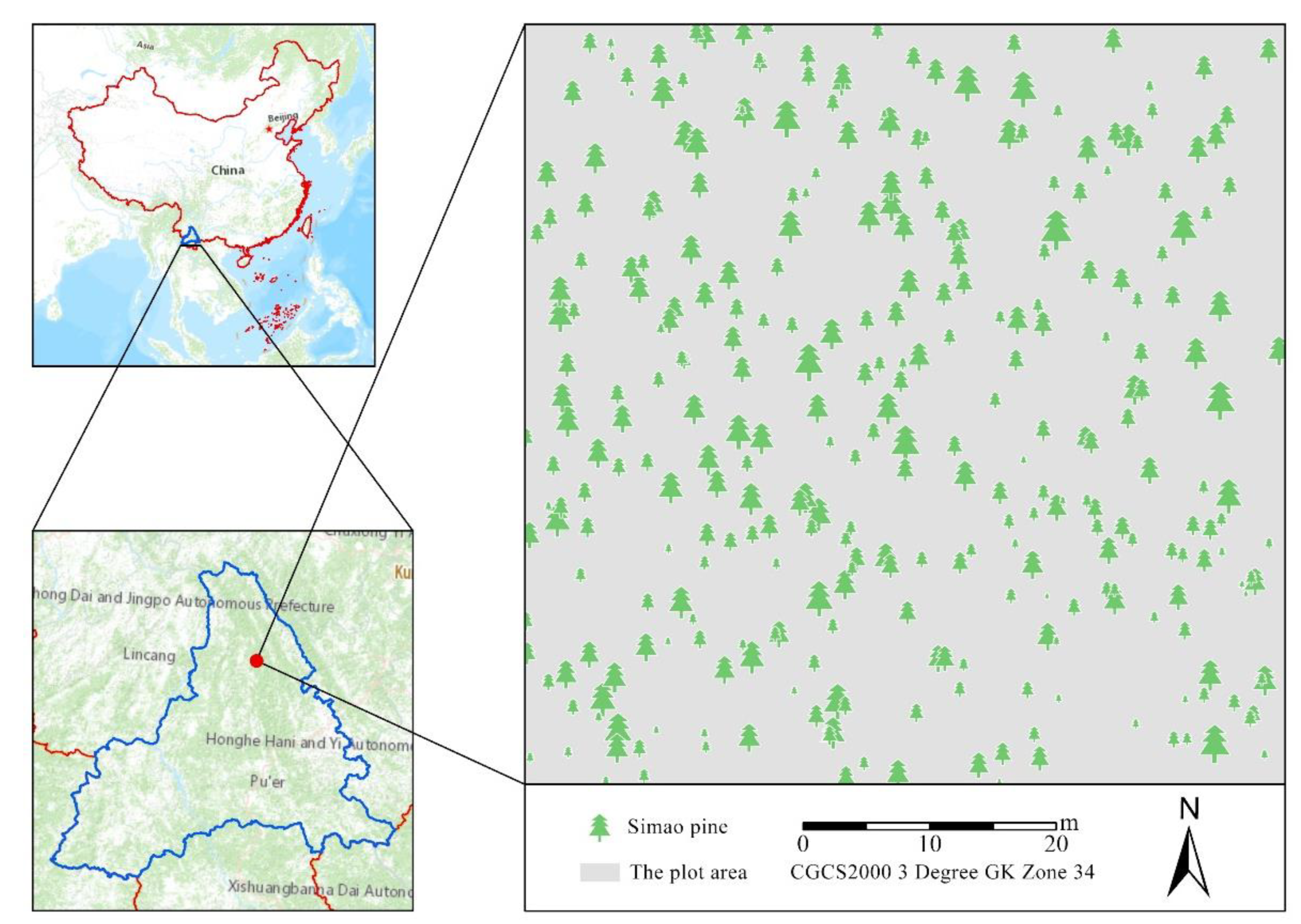
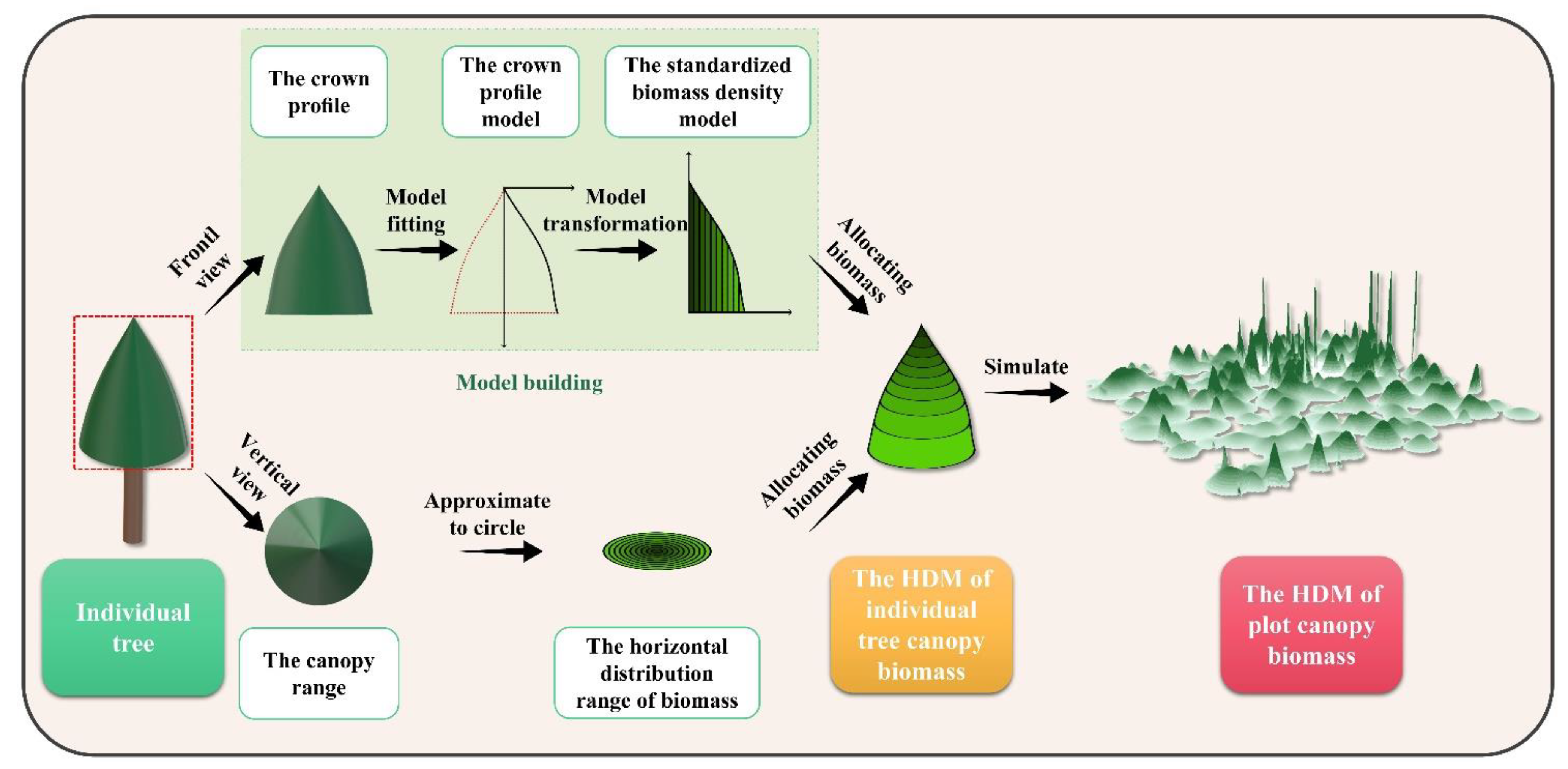

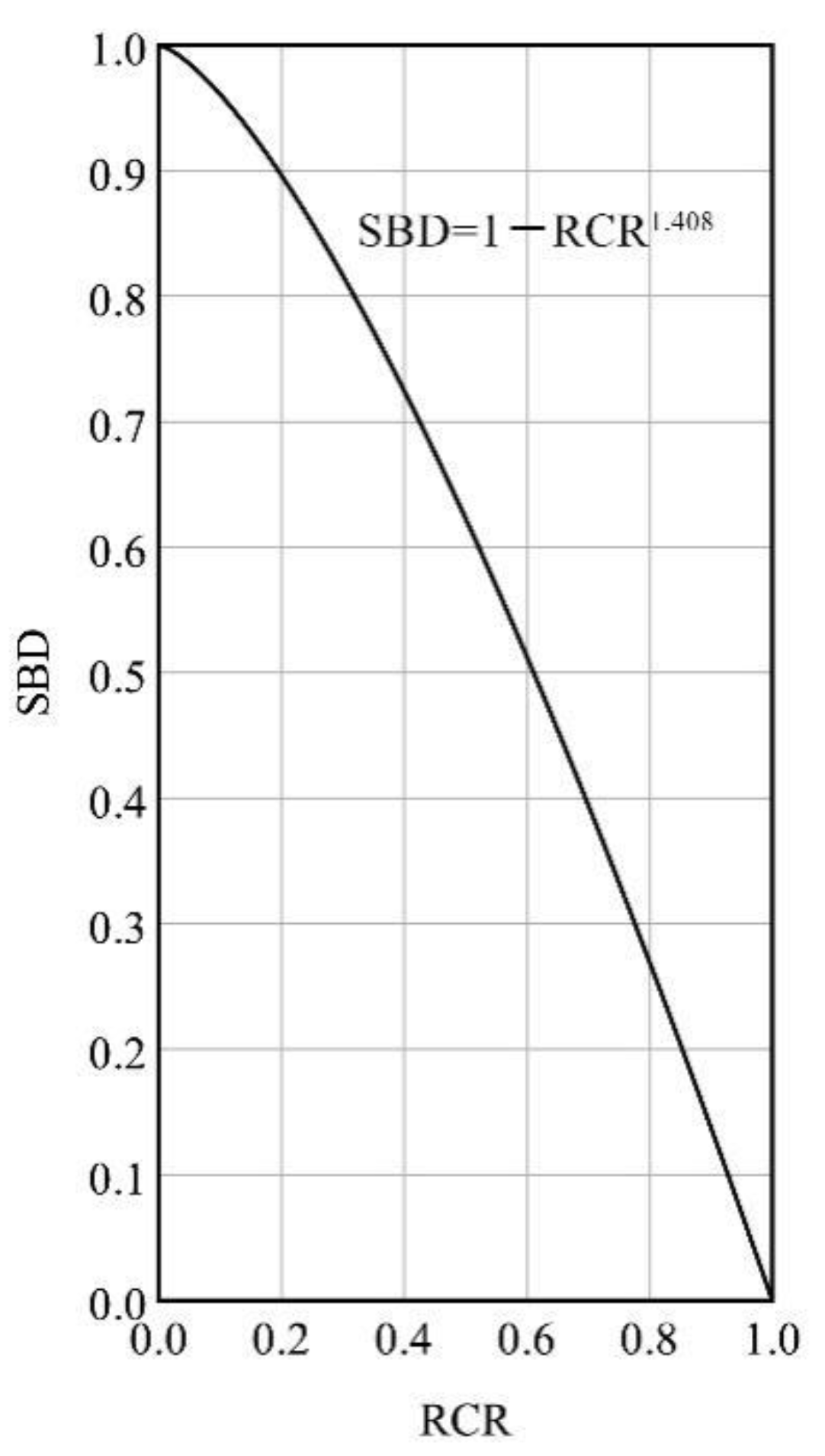
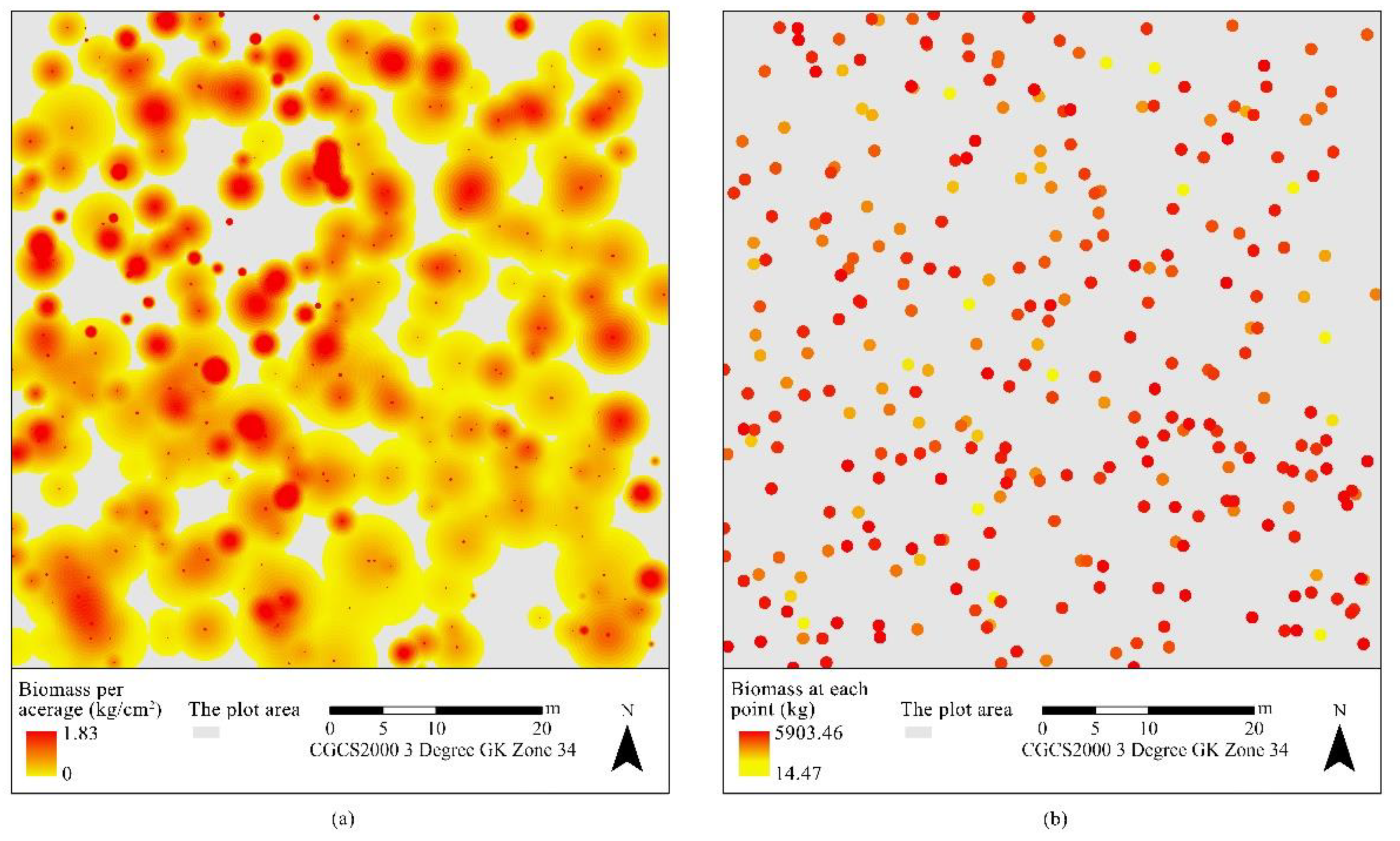
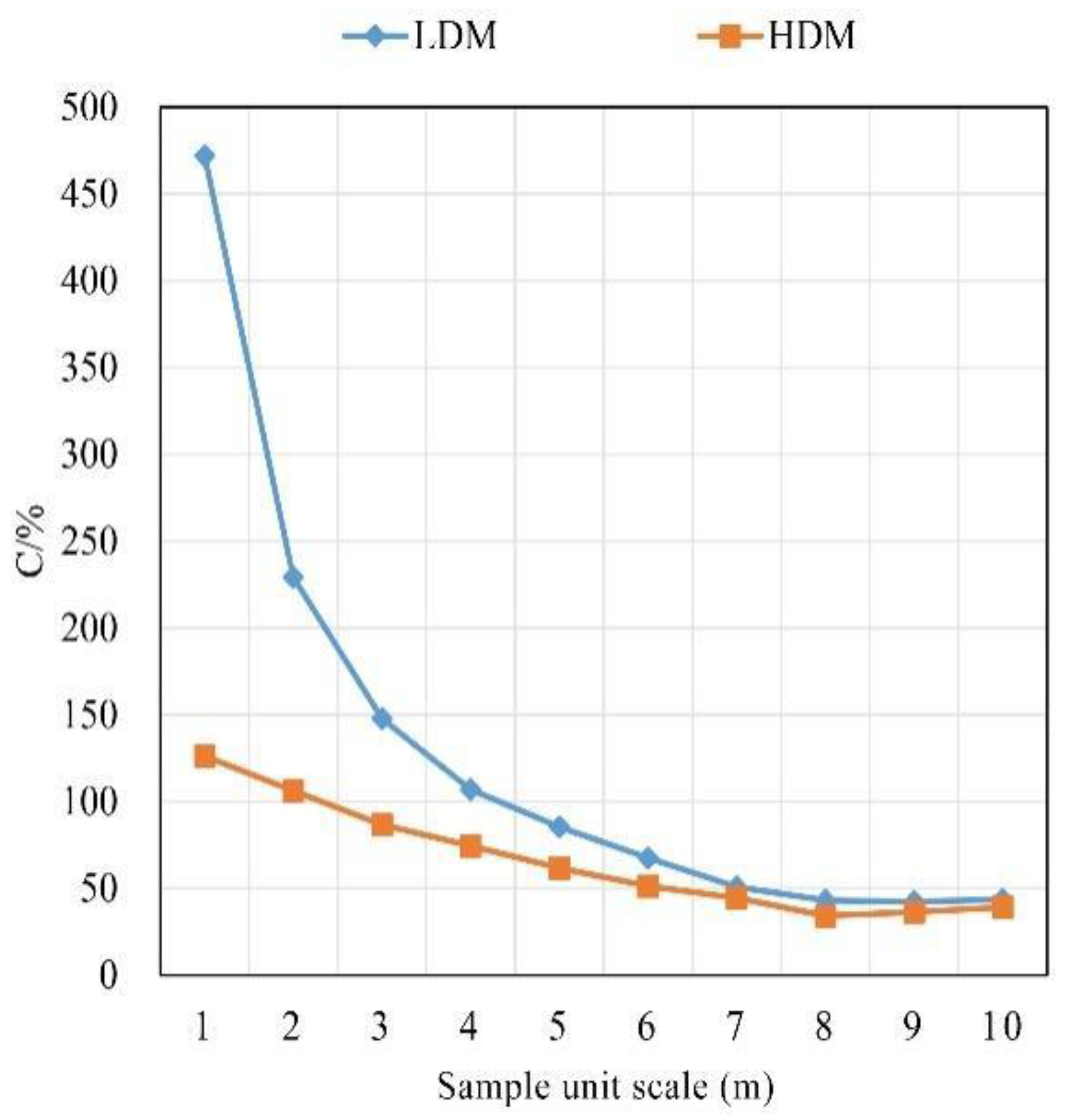

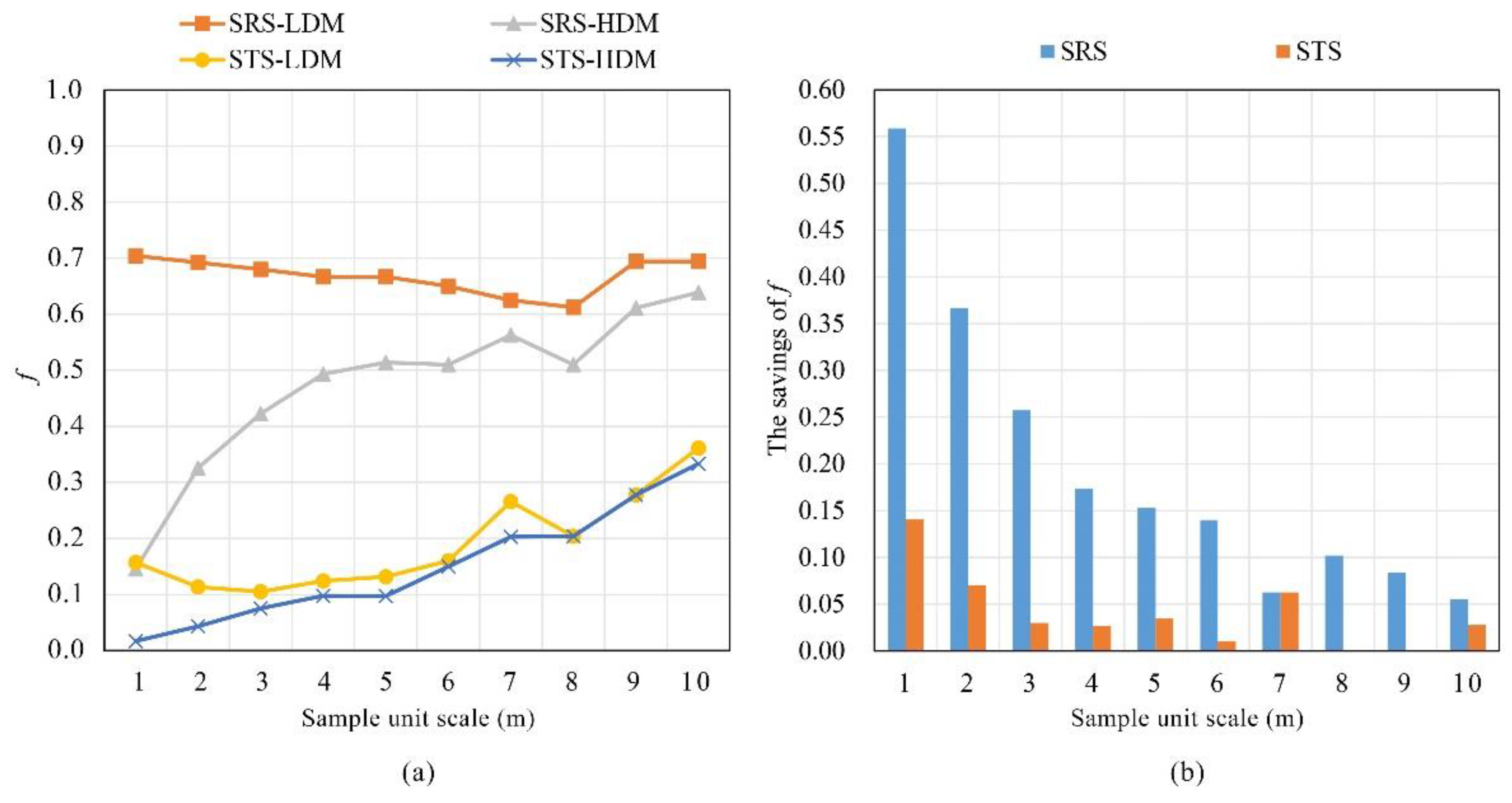
| Statistical Indicator | DBH (cm) | H (m) | CW (m) | Stem Biomass (kg) | Branch Biomass (kg) | Leaf Biomass (kg) | Total Biomass (kg) |
|---|---|---|---|---|---|---|---|
| Mean | 20.3 | 13.4 | 4.2 | 86.58 | 81.50 | 993.83 | 1161.91 |
| Sta. Dev. | 7.2 | 2.4 | 1.9 | 70.38 | 82.32 | 967.89 | 1120.27 |
| Min. | 5.7 | 3.2 | 0.2 | 2.49 | 0.74 | 11.23 | 14.47 |
| Max. | 37.9 | 17.4 | 10.0 | 349.28 | 441.65 | 5112.53 | 5903.46 |
| Data Type | Statistical Indicator | The Branch Angle (°) | The Depth into Crown (m) | The Branch Length (cm) | The Branch Chord Length (cm) | The Branch Diameter (cm) |
|---|---|---|---|---|---|---|
| Training Data (n = 69) | Mean | 75.7 | 2.71 | 1.89 | 1.65 | 2.41 |
| Sta. Dev. | 15.0 | 1.96 | 1.24 | 1.13 | 1.52 | |
| Min. | 30 | 0.29 | 0.3 | 0.3 | 0.2 | |
| Max. | 100 | 9.45 | 5.3 | 5.0 | 6.8 | |
| Testing Data (n = 23) | Mean | 72.5 | 2.77 | 1.79 | 1.57 | 2.46 |
| Sta. Dev. | 17.1 | 1.43 | 1.19 | 1.04 | 2.02 | |
| Min. | 40 | 0.25 | 0.1 | 0.3 | 0.4 | |
| Max. | 95 | 6.04 | 4.4 | 4.2 | 9.7 |
| Model | Parameter Estimation | Model Fitting | Test of Independence | |||||
|---|---|---|---|---|---|---|---|---|
| a | b | c | R2 | p-Value | RMSE | MAE | P (%) | |
| Power Function | 3.996 | 0.710 | — | 0.631 | <0.001 | 0.627 | 0.508 | 66.36 |
| Quadratic Parabolic Function | 0.288 | 5.010 | −1.338 | 0.628 | <0.001 | 0.630 | 0.509 | 68.72 |
| Logarithmic Function | 2.858 | 0.825 | — | 0.541 | <0.001 | 0.700 | 0.651 | 47.29 |
| Sample Unit Size (m) | Sample Method | Biomass Distribution | N | C (%) | Sampling Cost | Sampling Precision | |||
|---|---|---|---|---|---|---|---|---|---|
| n | f | MP (%) | MRE (%) | MCV (%) | |||||
| 1 | SRS | LDM | 3600 | 472.05 | 2535 | 0.70 | 90.01 | 4.02 | 5.09 |
| HDM | 3600 | 126.17 | 524 | 0.15 | 90.02 | 4.03 | 5.08 | ||
| STS | LDM | 3600 | 472.05 | 567 | 0.16 | 91.37 | 3.64 | 4.40 | |
| HDM | 3600 | 126.17 | 61 | 0.02 | 91.15 | 3.65 | 4.42 | ||
| 2 | SRS | LDM | 900 | 229.22 | 623 | 0.69 | 89.98 | 4.15 | 5.10 |
| HDM | 900 | 106.06 | 293 | 0.33 | 89.97 | 4.35 | 5.09 | ||
| STS | LDM | 900 | 229.22 | 102 | 0.11 | 91.07 | 3.71 | 4.50 | |
| HDM | 900 | 106.06 | 39 | 0.04 | 91.52 | 3.50 | 4.18 | ||
| 3 | SRS | LDM | 400 | 147.85 | 272 | 0.68 | 89.99 | 3.98 | 5.08 |
| HDM | 400 | 86.59 | 169 | 0.42 | 90.00 | 4.05 | 5.06 | ||
| STS | LDM | 400 | 147.85 | 42 | 0.11 | 91.77 | 3.30 | 4.06 | |
| HDM | 400 | 86.59 | 30 | 0.08 | 91.70 | 3.36 | 4.03 | ||
| 4 | SRS | LDM | 225 | 107.03 | 150 | 0.67 | 90.00 | 4.09 | 5.05 |
| HDM | 225 | 74.44 | 111 | 0.49 | 90.01 | 3.98 | 5.03 | ||
| STS | LDM | 225 | 107.03 | 28 | 0.12 | 91.19 | 3.55 | 4.26 | |
| HDM | 225 | 74.44 | 22 | 0.10 | 91.65 | 3.38 | 3.96 | ||
| 5 | SRS | LDM | 144 | 85.42 | 96 | 0.67 | 89.94 | 4.15 | 5.05 |
| HDM | 144 | 61.68 | 74 | 0.51 | 89.98 | 4.14 | 5.01 | ||
| STS | LDM | 144 | 85.42 | 19 | 0.13 | 90.88 | 3.55 | 4.25 | |
| HDM | 144 | 61.68 | 14 | 0.10 | 90.98 | 3.19 | 3.99 | ||
| 6 | SRS | LDM | 100 | 67.40 | 65 | 0.65 | 90.01 | 4.11 | 4.97 |
| HDM | 100 | 51.18 | 51 | 0.51 | 89.85 | 3.98 | 5.03 | ||
| STS | LDM | 100 | 67.40 | 16 | 0.16 | 91.45 | 3.31 | 3.88 | |
| HDM | 100 | 51.18 | 15 | 0.15 | 91.66 | 3.34 | 3.74 | ||
| 7 | SRS | LDM | 64 | 50.89 | 40 | 0.63 | 89.89 | 4.02 | 4.96 |
| HDM | 64 | 44.43 | 36 | 0.56 | 89.94 | 3.94 | 4.92 | ||
| STS | LDM | 64 | 50.89 | 17 | 0.27 | 92.26 | 3.07 | 3.55 | |
| HDM | 64 | 44.43 | 13 | 0.20 | 92.24 | 2.92 | 3.37 | ||
| 8 | SRS | LDM | 49 | 43.01 | 30 | 0.61 | 89.80 | 3.99 | 4.94 |
| HDM | 49 | 34.19 | 25 | 0.51 | 89.92 | 3.84 | 4.83 | ||
| STS | LDM | 49 | 43.01 | 10 | 0.20 | 91.50 | 2.73 | 3.31 | |
| HDM | 49 | 34.19 | 10 | 0.20 | 93.56 | 2.11 | 2.50 | ||
| 9 | SRS | LDM | 36 | 42.34 | 25 | 0.69 | 90.06 | 3.93 | 4.75 |
| HDM | 36 | 36.29 | 22 | 0.61 | 89.70 | 4.05 | 4.88 | ||
| STS | LDM | 36 | 42.34 | 10 | 0.28 | 92.06 | 2.53 | 3.09 | |
| HDM | 36 | 36.29 | 10 | 0.28 | 94.25 | 1.81 | 2.24 | ||
| 10 | SRS | LDM | 36 | 43.57 | 25 | 0.69 | 89.83 | 3.87 | 4.86 |
| HDM | 36 | 39.07 | 23 | 0.64 | 89.59 | 3.98 | 4.95 | ||
| STS | LDM | 36 | 43.57 | 13 | 0.36 | 93.08 | 2.45 | 3.00 | |
| HDM | 36 | 39.07 | 12 | 0.33 | 92.43 | 2.86 | 3.20 | ||
Publisher’s Note: MDPI stays neutral with regard to jurisdictional claims in published maps and institutional affiliations. |
© 2022 by the authors. Licensee MDPI, Basel, Switzerland. This article is an open access article distributed under the terms and conditions of the Creative Commons Attribution (CC BY) license (https://creativecommons.org/licenses/by/4.0/).
Share and Cite
Lu, C.; Xu, H.; Zhang, J.; Wang, A.; Wu, H.; Bao, R.; Ou, G. A Method for Estimating Forest Aboveground Biomass at the Plot Scale Combining the Horizontal Distribution Model of Biomass and Sampling Technique. Forests 2022, 13, 1612. https://doi.org/10.3390/f13101612
Lu C, Xu H, Zhang J, Wang A, Wu H, Bao R, Ou G. A Method for Estimating Forest Aboveground Biomass at the Plot Scale Combining the Horizontal Distribution Model of Biomass and Sampling Technique. Forests. 2022; 13(10):1612. https://doi.org/10.3390/f13101612
Chicago/Turabian StyleLu, Chi, Hui Xu, Jialong Zhang, Aiyun Wang, Heng Wu, Rui Bao, and Guanglong Ou. 2022. "A Method for Estimating Forest Aboveground Biomass at the Plot Scale Combining the Horizontal Distribution Model of Biomass and Sampling Technique" Forests 13, no. 10: 1612. https://doi.org/10.3390/f13101612





